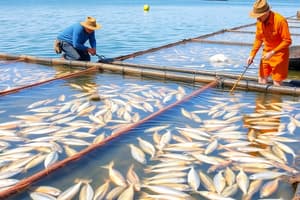Podcast
Questions and Answers
What is the primary purpose of live feed in aquaculture?
What is the primary purpose of live feed in aquaculture?
- To provide nutritional support to fish (correct)
- To replace artificial feed completely
- To enhance water quality
- To act as a habitat for fish
Which category does phytoplankton belong to in live feed culture?
Which category does phytoplankton belong to in live feed culture?
- Plant life (correct)
- Microorganisms
- Fungi
- Animal life
What is one of the main assessment methods in the live feed culture course?
What is one of the main assessment methods in the live feed culture course?
- Final examination
- Peer assessment
- Continuous assessment (correct)
- Oral presentation
In the context of live feed culture, what does zooplankton refer to?
In the context of live feed culture, what does zooplankton refer to?
Which topic is NOT included in the live feed culture course?
Which topic is NOT included in the live feed culture course?
What is one objective of the live feed culture topic?
What is one objective of the live feed culture topic?
How many practical work assessments are included in the course evaluation?
How many practical work assessments are included in the course evaluation?
Which of the following is true about the live feed culture?
Which of the following is true about the live feed culture?
What role do phytoplankton play in aquatic ecosystems?
What role do phytoplankton play in aquatic ecosystems?
Which of the following is NOT a type of phytoplankton?
Which of the following is NOT a type of phytoplankton?
How do zooplankton obtain energy?
How do zooplankton obtain energy?
What characteristic distinguishes zooplankton from phytoplankton?
What characteristic distinguishes zooplankton from phytoplankton?
Which of the following organisms is classified as zooplankton?
Which of the following organisms is classified as zooplankton?
Where are phytoplankton primarily found in aquatic environments?
Where are phytoplankton primarily found in aquatic environments?
Which characteristic is true about microalgae?
Which characteristic is true about microalgae?
Which organism is NOT a type of zooplankton?
Which organism is NOT a type of zooplankton?
Flashcards are hidden until you start studying
Study Notes
Live Feed Culture Overview
- Live feed culture is vital for aquaculture, encompassing organisms consumed by economically significant fish.
- It is categorized into two groups: phytoplankton (plant-based) and zooplankton (animal-based).
Phytoplankton Characteristics
- Comprises unicellular, colonial, or filamentous organisms.
- Functions as primary producers in aquatic ecosystems through photosynthesis.
- Invisible to the naked eye; visible as green patches when abundant.
- Includes microalgae species such as diatoms, dinoflagellates, and cyanobacteria.
- Examples: Chlorella, Nannochloropsis, Skeletonema, Dunaliella, Chaetoceros, Scenedesmus, Arthrospira, Closterium, Isochrysis, Navicula, Spirogyra, Oscillatoria, Westella, Anabaena.
Zooplankton Characteristics
- Comprised of small aquatic animals and protozoans.
- Key consumers of phytoplankton, obtaining energy and nutrients for survival.
- Generally visible to the naked eye and found in the water's mid-layer.
- Includes species such as Rotifer, Daphnia, Moina, Tubifex, Copepod, and Artemia sp.
Indoor and Outdoor Culture Techniques
- Various techniques are employed to cultivate live feed for aquaculture, with distinctions between indoor and outdoor methods.
Harvesting Techniques
- Specific practices are utilized to efficiently harvest both phytoplankton and zooplankton for use in aquaculture.
Assessment Methods
- Continuous assessment accounts for a total of 100% of the evaluation.
- Breakdown of components includes theory tests (30%), practical work (60%), and case studies (10%).
Topic Objectives
- Understand and explain live feed culture and its significance in aquaculture.
- Classify live feed organisms correctly into phytoplankton and zooplankton.
- Explore the technological methods for cultivating live feed in the aquaculture industry.
Studying That Suits You
Use AI to generate personalized quizzes and flashcards to suit your learning preferences.




